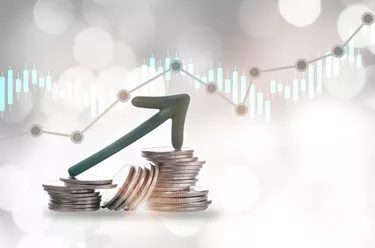
Investing in stocks can be a great method for getting a return on your money, but you need to be able to choose a stock properly. In addition, you have to give it time to grow naturally. Unless you're looking to become a risky day trader, your investment can take years to grow. This makes it very important to choose stocks that will perform the way you expect them to over time. Most investment companies provide a lot of information on the performance of different stocks, but there may be times you want to calculate values on your own to compare stocks against each other.
Stock Growth Rate Formula
Video of the Day
There are a few ways to measure the growth of a stock over time. The simplest way is to look at the bulk growth of an investment over time as a percentage. It doesn't necessarily give you a lot of detail, but this figure will let you compare one investment to another at a high level.
Video of the Day
You'll need to decide the time period you'll look at; too short of a time period may not capture the behavior of the stock, but too long might average out aberrant behavior. For example, consider looking at a single year. Take the value of the stock at the beginning of the year and subtract it from the value at the end of the year to find the difference in value. If it's positive, the stock has gained value; if it's negative, it has lost value. Either way, divide the change in price by the original value of the stock, then convert this value into a percentage. This is the growth rate for that one stock over that one year.
You can use the stock growth rate formula to calculate this. For example, if you have an investment that was worth $500 at the beginning of 2020, and it is worth $650 at the end of 2021 (two years total), its basic growth rate becomes ($650 - $500) / ($500) = 0.30, which is 30 percent. You can use a stock growth rate calculator to help you with this figuring if need be.
Compound Interest and Growth Rate
However, if you're looking at an investment with compound interest, things change a bit. An investment that earns interest money and then reinvests those earnings at set intervals is considered to earn compound interest, and the calculation is a bit more complicated.
Consider the previous example. Because this investment would have collected the interest it made in 2020 and reinvested it in 2021, the 30 percent growth rate doesn't tell the whole story. In this case, you can use a formula for the compound annual growth rate (CAGR) to calculate the growth rate, explain the writers for the Corporate Finance Institute. This formula isn't perfect, as it assumes that the growth rate is constant over the period you're looking at, but it manages to capture how interest affects growth.
In this case, the formula for growth rate is: GR = [ (ending value) / (beginning value) ] ^ (1/n) - 1, where n is the number of years, assuming interest is compounded annually. So for this example: ($650 / $500) = 1.3, and 1/n = ½ = 0.5, so (1.3) ^ (0.5) = 1.1401 - 1 = 0.14, or 14 percent.
Regular vs. Compound Growth Rates
You'll see that this value for compound growth rates is very different than the 30 percent originally noted. This is because the first year, that $500 investment made about $70 in interest, which was then added back into the investment.
The second year, the investment of $570 then compounded again, bringing you to the final value of $650. This is a much more meaningful way to compare investments since it includes the money that's reinvested.
Consider also: How to Calculate a Five Year CAGR